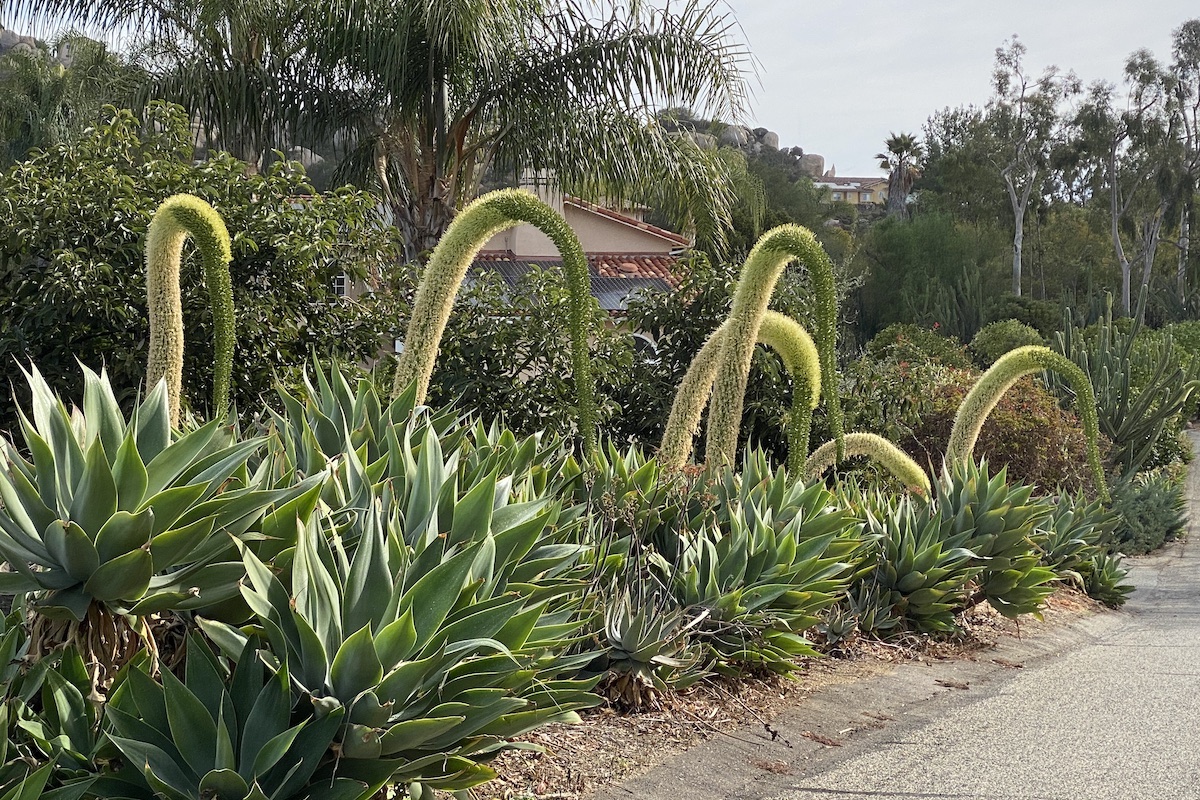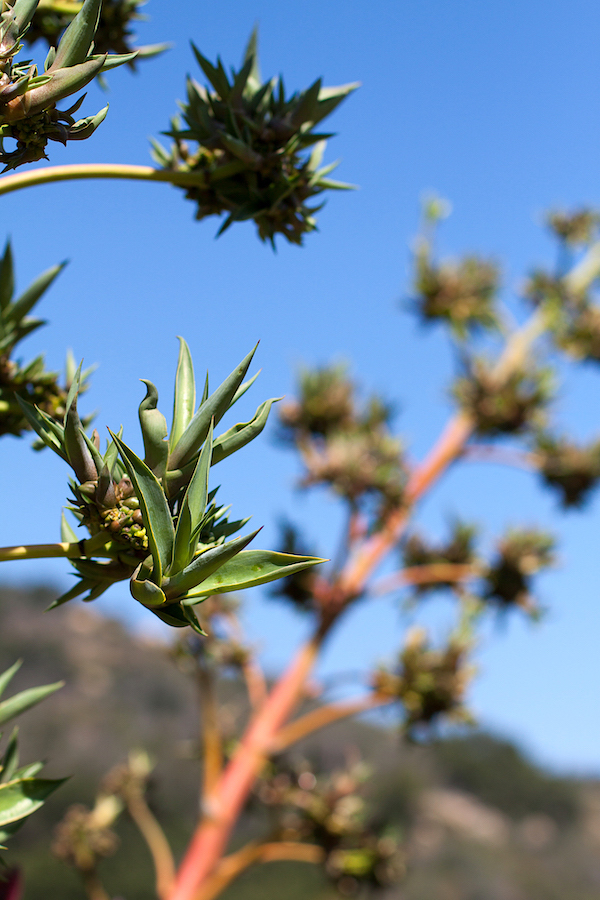In my new video and the Q&A below, I talk about what you should do when your agaves bloom.
Agave flower stalks tend to be impressively tall relative to the plants. There are two forms: unbranched with blooms along the stalk, and branching with clusters of flowers.
Flowers’ sweet nectar attracts hummingbirds, bees, and other pollinators. Blooms turn into seedpods or bulbils that are clones of the mother plant.
When an agave plant that is dying can’t hold up its tall stalk any longer, it falls over, sending seeds or young plants to the ground.
Seeing an agave send up its towering flower spike is an awe-inspiring event for any gardener. The huge blooms seem to emerge overnight, rising up like a giant green asparagus spear. But this last glorious display comes at a cost for agaves. These sculptural succulents are monocarpic, meaning they die after flowering just once.
This natural cycle unfolds over many years. So while agaves do perish after blooming, they live on by producing offsets or “pups” beforehand. Understanding the agave lifecycle helps us appreciate their fleeting floral show while propagating the next generation.
The Agave Bloom Sequence
Agaves are supremely well adapted to their native, arid habitats. To survive harsh conditions they’ve evolved to follow a predictable bloom sequence
-
Maturation – Agaves spend years, even decades, building up energy reserves before sending up a bloom stalk. The plant grows steadily, forming its signature rosette shape
-
Flowering – When mature, the agave invests its stored resources into a towering flower spike up to 30 feet tall.
-
Decline – This huge energy expenditure depletes the mother plant. As flowering finishes the main rosette fades and withers away.
-
Rebirth – But the agave lives on by producing offsets from its base before dying. These “pups” or small clones allow propagation.
So while agaves do die after that fantastic final flowering, they cleverly produce offspring beforehand to continue their legacy.
Why Flowering is Fatal for Agaves
Constructing that massive flower spike proves fatal because it saps the agave of all its life resources. Here’s a closer look at why agaves commit everything to this culminating bloom:
-
The bloom stalk can extend 20-40 feet skyward, requiring extensive energy reserves to fuel such rapid growth.
-
Hundreds of individual flowers cover the stalk, opening progressively over weeks. Producing such bountiful blooms is incredibly taxing.
-
Nectar-rich flowers entice pollinators like bats, birds, and insects, ensuring reproduction occurs before death. But making ample nectar extracts a heavy toll.
-
Seed production further drains the plant after pollination. Each flower can yield dozens of seeds.
-
Root and vascular tissues deteriorate as resources get re-routed to the urgent need for flowering. This disables water and nutrient uptake.
-
With its life force channeled into this final fling at reproduction, the mother agave simply cannot sustain basic functions, causing demise.
Propagating Agave Pups
While we can’t prevent an agave’s inevitable demise after flowering, we can propagate new plants through “pups” that form around the base:
-
Leave pups attached at first to let them bulk up after flowering starts. Monitor for when they detach naturally.
-
Sever thicker, mature offsets with sterilized shears and re-plant in well-draining soil. Water sparingly until established.
-
Carefully separate crowded pups, moving the largest ones first to prevent transplant shock. Transplant smaller offsets later.
-
Stake unstable new plants until sufficient roots develop. Mist occasionally until signs of growth resume.
-
Anchor potted pups properly to avoid toppling from the stalk’s weight. Monitor drainage closely.
By nurturing these basal offsets, you can perpetuate favored agave varieties after the mother plant expires.
Collecting Aerial Bulbils
Some agave species also produce aerial bulbils along the bloom spike, allowing further propagation:
-
Bulbils form after flowers fade, replacing spent blooms on the stalk. They resemble mini pinecones.
-
Let the stalk dry and topple over naturally, then harvest bulbils by twisting or cutting them off.
-
Briefly dry bulbil ends before planting to avoid rotting. Then plant just below the soil surface.
-
Water cautiously at first and provide partial shade to encourage roots. Gradually transition to full sun.
-
Remove spent flower stalks carefully to avoid spreading sharp fiberglass-like threads when they detach.
Rescuing and planting agave bulbils lets you recreate beloved varieties when the original plant finishes flowering.
Caring for Mature Agaves Post-Bloom
When your prized agave begins blooming, provide some extra care to maximize its final display:
-
Stake emerging bloom stalks if needed for support against toppling in rain or wind.
-
Position potted plants carefully to avoid tipping under the heavy stalk’s weight.
-
Water thoroughly then allow drying between drinks to support flowering metabolism.
-
Applying diluted liquid fertilizer can aid nutrient demands from intense blooming.
-
Monitor for secondary rots that can accelerate decline of the fading plant.
-
Prune deteriorating outer leaves but leave younger center leaves intact.
-
Shelter from harsh sun and inclement weather that can stress the weakened plant.
While we can’t stop the agave’s inevitable demise after flowering, attentive care helps ensure it exits with a dramatic final act.
Key Takeaways
-
Appreciate the ephemeral beauty of its monumental flower spike before it finishes.
-
Know that the mother plant is destined to die off after this final flowering phase.
-
Propagate new starts from pups emerging at the base before the parent plant expires.
-
Harvest any aerial bulbils that form on the dying bloom stalk.
-
Care for the fading original agave while also propagating its replacements.
-
Transplant and nurture agave offspring in suitable conditions to continue the lifecycle.
Losing a treasured mature agave can be bittersweet. But we find solace in planting its next generation to carry on its unique legacy. With proper propagation, the agave’s genetic line can grace your landscape for years to come.

How to get baby plants?
When the bloom stalk is fully grown and the mother plant is no longer green, you can pick the bulbils or seeds. Plant them in nursery flats or small pots and wait for them to double in size. Then move them to bigger pots or the garden. In the video, see agave expert Jeremy Spath start seeds.
How long until an agave blooms?
Flowering can take an agave years-sometimes decades, depending on the species. Jeff Moore is an author and run a succulent nursery. He says, “In our book on agaves, we list those that go off fairly quickly, like Agave vilmoriniana and A desmetiana, but otherwise we just deferred to the 15-25 year average. ”.

Did you know that agave plants can actually die after flowering?
FAQ
What to do with agave after it blooms?
Does the agave plant die after it flowers?
How long does an agave live after it blooms?
Does agave only bloom once?
